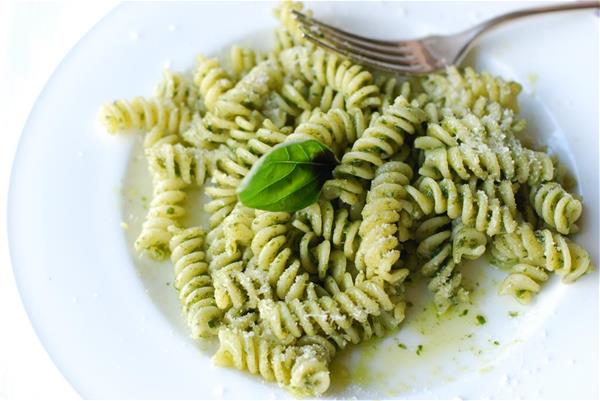Basil pesto from Liguria is a food with working class roots, eaten by sailors to stay healthy at sea. Today people around the world make basil pesto, but the best is still made in Italy. And when you use it to sauce good pasta, you have the ultimate summer dinner.
At the northern edge of Liguria lies the glamorous Italian Riviera.
In the summer it’s crammed with yachts, linen suits and fabulous sunglasses. To the south lies the huge working port of Genoa. While it’s a lot more fun to visit the north and drink prosecco seaside in Portofino, it’s Genoa we have to thank for pesto, the classic basil and olive oil sauce.
Long-haul ocean sailors—of which Genoa had a lot—were traditionally at risk for scurvy, caused by a lack of vitamin C. Before refrigeration it was difficult to keep fruits and vegetables edible on long journeys. Pesto solved that. It’s high in vitamin C and, thanks to the olive oil it’s stored in, doesn’t go bad. (That’s still how you should store it today: after opening the jar, top it up with a bit of olive oil and store it in the refrigerator. The oil will turn solid in the cold but will return to liquid at room temperature.) Sailors could keep it in a barrel all the way across the ocean and back, eating it on pasta or bread along the way. It makes me wonder what pirates did when they boarded a Genoan vessel. Did they take the pesto? Were pirates pesto eaters?
Years ago I invested in a big mortar and pestle from Liguria, and from time to time I make pesto at home, pounding pine nuts, basil and olive oil together for an interminable length of time. The results are never the same as I’ve tasted in Italy or even tasted from Roi. It’s kind of like tomato sauce. I’ve made that at home, too. But I’ve never made any as good as Il Mongetto. I think the difference is the quality of the main ingredients. In this case, the basil.
Basil grows easily in Liguria’s sunny, temperate climate.
It’s harvested young. When just two leaves have sprouted on the plant, that’s it—time for picking. That keeps it very sweet and herbaceous. It doesn’t suffer the hot licorice flavors you get when basil is harvested later in its life, in big stalks, like we usually see at the market in America. Ligurian olive oil, the other main ingredient, is delicate and sweet, a good match for basil whose flavors would be overwhelmed by a more robust oil.
When we send for pesto from Franco and Rosella at Roi, it’s made to order with their excellent olive oil and, perhaps not surprisingly, sent to Genoa. Sailors pack it in a container vessel headed to New York. I don’t know what they eat on board, but a part of me hopes it’s pesto.
Serving Pesto
We all know pesto as a sauce for pasta, and I’ll come back to that in a moment. But pasta isn’t the only thing I like to pair with it. Spread it on pizza. Mix a dollop into a light, summery soup. In Liguria, they like to use it to sauce a dish of cooked potatoes and green beans.
To serve pesto over pasta, it helps to start with great pasta. Here are a few details I’ve learned about cooking pasta over the years. Each one is a small thing but, added up, I think they make a big difference in the way it tastes.
- Salt. I salt the water pretty heavily as soon as I put the water on. “Salty like the sea,” says Signora Passalacqua, the mother of my Sicilian friend Gioacchino. (He’s the export help we use for many foods we carry, like the Sicilian sun dried tomatoes, which, as it turns out, go great in pasta and with pesto.) Salty water gives the pasta a base of flavor you just can’t get salting afterwards. I use the French grey sea salt. Dollar per pound, it’s still the best sea salt I’ve ever tasted.
- Stir soon. As soon as I add the pasta to the water I stir. This is the best way I’ve found to keep it from clumping and sticking.
- Stop short. I cut the cooking short of done, when it’s still very al dente, i.e. it has a bit of snap to it.
- There and back again. I drain the water, shake the pasta once or twice then quickly return it to a warm pot, mixing it with the sauce. The extra bit of cooking with the sauce softens it further and, instead of absorbing water, the pasta absorbs sauce, making it even more flavorful.
- Warm bowls. I drain the hot pasta water into the bowls and toss it out just before serving.
I don’t add oil to the water, run water on it after it’s cooked, or throw a piece against the wall to see if it’s done, which are weird tricks I’ve tried once or twice in my day. In my experience, most of those things don’t do much to help the cooking. Some even hurt.
And then for the pesto. Combine a spoonful or two of the pesto with grated Parmigiano Reggiano cheese or, if you prefer, a sweet Pecorino. Since pesto is concentrated, toss it with a splash or two of the starchy water the pasta cooked in to thin it out and help it grip the pasta. Stir it into warm pasta and top with a bit more grated cheese.

